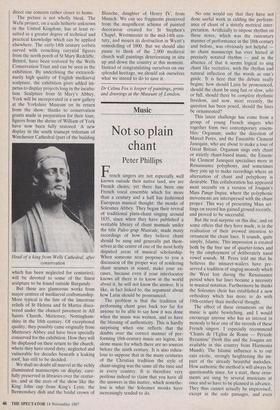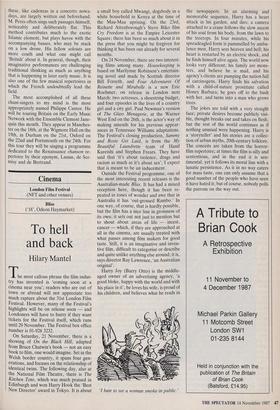M us ic
Not so plain chant
Peter Phillips
French singers are not especially well known outside their native land, nor are French choirs; yet there has been one French vocal ensemble which for more than a century and a half has fashioned European musical thought: the monks of Solesmes Abbey. They began their revival of traditional plain-chant singing around 1835, since when they have published a veritable library of chant manuals under the title Paleo grap Musicale, made many recordings of how they believe chant should be sung and generally put them- selves at the centre of one of the most hotly disputed areas of musical scholarship. When someone next proposes to you a discussion of the proper way of rendering chant neumes in sound, make your ex- cuses, because even if your interlocutor knows all there is to know in the world about it, he will not know the answer. It is like, in fact linked to, the argument about how Latin should be pronounced.
The problem is that the tradition of performing chant goes back too far for anyone to be able to say how it was done when the music was written, and so have the blessing of authenticity. This is hardly surprising when one reflects that the doubts over the correct manner of per- forming 18th-century music are legion, let alone music for which there are no sources before the ninth century. It is also ridicu- lous to suppose that in the many centuries of the Christian tradition the style of chant-singing was the same all the time and in every country. It is therefore very perilous indeed to claim that you have all the answers in this matter, which nonethe- less is what the Solesmes monks have increasingly tended to do. No one would say that they have not done useful work in ridding the perform- ance of chant of a strictly metrical inter- pretation. Artificially to impose rhythm on these notes, which was the customary manner of performance in the 18th century and before, was obviously not helpful no chant manuscript has ever hinted at precisely notated rhythm — and in the absence of that it seems logical to sing chant like recitative, with the rhythm and natural inflection of the words as one's guide. It is here that the debate really begins: how should Latin be pronounced, should the chant be sung fast or slow, solo or full, should there be complete rhythmic freedom, and now, most recently, the question has been posed, should the lines be ornamented?
This latest challenge has come from a group of young French singers who together form two contemporary ensem- bles: Organum, under the direction of Marcel Peres, and the Ensemble Clement Janequin, who are about to make a tour of Great Britain. Organum sings only chant or strictly chant-based music, the Ensem- ble Clement Janequin specialises more in Renaissance polyphony, and sometimes, they join up to make recordings where an alternation of chant and polyphony is desirable. This collaboration has appeared most recently on a version of Josquin's Mass Pange lingua, where the polyphonic movements are interspersed with the chant proper. This way of presenting Mass set- tings on record has gained ground recently, and proved to be successful.
But the real surprise on this disc, and on some others that they have made, is in the realisation of their avowed intention to ornament the chant lines. It sounds, quite simply, Islamic. This impression is created both by the free use of quarter-tones and by the employment of deliberately nasal vowel sounds. M. Peres told me that he believes the minaret-wailers have pre- served a tradition of singing monody which the West lost during the Renaissance period when bar lines became a necessity in musical notation. Furthermore he thinks the Solesmes choir has established a new orthodoxy which has more to do with 19th-century than medieval thought.
The effect of these ornaments on the music is quite bewitching, and I would encourage anyone who has an interest in monody to hear one of the records of these French singers. I especially recommend `Chants de l'Eglise de Rome — Pe riode Byzantine' (both this and the Josquin are available in this country from Harmonia Mundi). The Islamic influence is to our ears exotic, strongly heightening the im- pact of the already beautiful melodies. How authentic the method is will always be questionable since, for a start, these orna- ments are sung by several musicians at once and so have to be planned in advance. They thus cannot actually be improvised, except in the solo passages, and even these, like cadenzas in a concerto nowa- days, are largely written out beforehand. M. Peres often sings such passages himself, noticeably and deliberately flat. This method contributes much to the exotic Islamic element, but plays havoc with the accompanying basses, who may be stuck on a low drone. His fellow soloists are more couth and what one might call `British' about it. In general, though, their imaginative performances are challenging traditional thinking as much as anything that is happening in later early music. It is also one of the few musical repertoires in which the French undoubtedly lead the field.
The most accomplished of all these chant-singers to my mind is the most appropriately, named Philippe Cantor. He will be touring Britain on the Early Music Network with the Ensemble Clement Jane- quin this month. They appear in Manches- ter on the 18th, at the Wigmore Hall on the 19th, in Durham on the 21st, Oxford on the 22nd and Portsmouth on the 24th. For this tour they will be singing a programme dedicated to the Renaissance chanson re- pertoire by their eponym, Lassus, de Ser- misy and de Bertrand.











































































 Previous page
Previous page